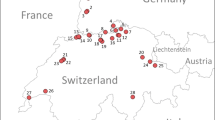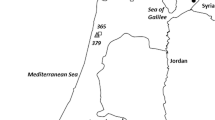Abstract
The genetic structure of ten grape phylloxera populations, sampled in summer of 2006 and 2007 from four distinct viticultural areas in Austria, Daktulosphaira vitifoliae (Fitch) (Homoptera: Phylloxeridae) was analyzed using six SSR markers (Dvit1-Dvit6). Leaf-feeding populations were chosen from similar ecological habitats, where susceptible rootstock hosts have overtaken scions in abandoned vineyards and produce grape phylloxera populations. To study population structures and test for dominating genotypes, population genetic measures were performed. The genetic diversity detected within the entire set of 315 genotypes was high, with 223 distinct multilocus genotypes (MLGs). Excess of heterozygotes and significant deviations from Hardy-Weinberg equilibrium in some populations indicated that the major reproduction mode in these populations is asexual but, sexual reproduction also confirmed by the sign. P sex values. The genetic diversity within populations was higher than between populations, although only three overlapping genotypes could be found. MLGs were rare, indicating that no candidate for superclones were detected in the leaf-feeding populations studied.

Similar content being viewed by others
References
Arnaud‐Haond, et al. (2007). Standardizing methods to address clonality in population studies. Molecular Ecology, 16, 5115–5139.
Caron, V., Ede, F.J., Sunnucks, P. (2014) Unravelling the paradox of loss of genetic variation during invasion: Superclones may explain the success of a clonal invader. PLoS ONE, 9(6), art. no. e97744.
Corrie, A. M., Crozier, R. H., van Heswijck, R., & Hoffman, A. A. (2002). Clonal reproduction and population genetic structure of grape phylloxera Daktulospaira vitifoliae. in Australia. Heredity, 88, 203–211.
Downie, D. A. (2002). Locating the sources of an invasive pest, grape phylloxera, using a mitochondrial DNA gene genealogy. Molecular Ecology, 11(10), 2013–2026.
Downie, D. A., Grannett, J., & Fisher, J. R. (2000). Distribution and abundance of leaf galling and foliar sexual morphs of grape phylloxera and Vitis species in the central and eastern United States. Environmental Entomology, 29, 979–986.
Fenton, B., Woodford, J. A. T., & Malloch, G. (1998). Analysis of clonal diversity of the peach-potato Myzus persicae (Sulzer) in Scotland. UK and evidence for the existence of a predominant clone. Molecular Ecology, 7, 1475–1487.
Forneck, A., & Huber, L. (2009). (A)sexual reproduction – a review of life cycles of grape phylloxera. Daktulosphaira vitifoliae. Entomologia Experimentalis et Applicata, 131, 1–10.
Forneck, A., Walker, M. A., & Blaich, R. (2000). Genetic structure of an introducted pest. Grape phylloxera (Daktulopshaira vitifoliae Fitch) in Europe. Genome, 41, 669–678.
Forneck, A., Walker, M. A., & Blaich, R. (2001). Ecological and genetics aspects of Grape Phylloxera’s (Daktulosphaira vitifoliae Fitch) performance on rootstock hosts. Bulletin of Entomological Research, 91, 445–451.
Goudet, J. (1995). FSTAT Version 1.2: a computer program to calculate F-statistics. The Journal of Heredity, 86, 485–486.
Granett, J., & Kocsis, L. (2000). Populations of grape phylloxera gallicoles on rootstock foliage in Hungary. Vitis, 39, 37–41.
Granett, J., Walker, A. M., Kocsis, L., & Omer, A. D. (2001). Biology and management of grape phylloxera. Annual Review of Entomology, 46, 387–412.
Guo, S. W., & Thompson, E. A. (1992). Performing the exact test of Hardy-Weinberg proportion for multiple alleles. Biometrics, 48, 361–372.
Halkett, F., Plantegenest, M., Prunier-Leterme, N., Mieuzet, L., Delmotte, F., & Simon, J. C. (2005). Admixed sexual and facultatively asexual aphid lineages at mating sites. Molecular Ecology, 14(1), 325–336.
Herbert, K. S., Hoffmann, A. A., & Powell, K. S. (2006). Changes in grape phylloxera abundance in ungrafted vineyards. Journal of Economic Entomology, 99(5), 1774–1783.
Islam, M.S., Roush, T.L., Walker, M.A., Granett, J., Lin, H. (2013) Reproductive mode and fine-scale population genetic structure of grape phylloxera (Daktulosphaira vitifoliae) in a viticultural area in California. BMC Genetics, 14, art. no. 123.
Kocsis, L. & Bari, I. (2013) Preference and performance of leaf-galling grape phylloxera on Vitis sp. Cultivars. 6th International Symposium on Phylloxera. Bordeaux. France.
Koennecke, T., Aigner, C., Specht, S., Lawo, N. C., & Forneck, A. (2011). A stepwise assessment of Daktulosphaira vitifoliae infested grapevines in a Viennese vineyard site. Acta Horticulturae, 904, 59–62.
Lund, K. (2013) Phylloxera Biodiversity. PhD Thesis University of California, Davis. 120pp.
Lynch, C. M. (1984). Destabilizing hybridization. general-purpose genotypes and geographic parthenogenesis. Quarterly Review of Biology, 59, 257–290.
Müller, N. (2010) Verwilderte Reben an den Böschungen des Kaiserstuhls. Diplomarbeit. Albert-Ludwigs-Universtität Freiburg i.Br. Fakultät für Biologie. 77 pp
Nei, M. (1978). Estimation of average heterozygosity and genetic distance from a small number of individuals. Genetics, 89(3), 583–590.
Powell, K. S., Cooper, P. D., & Forneck, A. (2013). The biology, physiology and host-plant interactions of grape phylloxera daktulosphaira vitifoliae. Advances in Insect Physiology, 45, 159–218.
Raymond, M., & Rousset, F. (1995). GENEPOP (version 1.2): population genetics software for exact tests and ecumenicism. Journal of Heredity, 86:248–249
Riaz, S., Lund, K., Lin, H., & Walker, M. A. (2014). Development and characterization of a large set of microsatellite markers for grape phylloxera (Daktulosphaira vitifoliae Fitch). Vitis, 53(2), 95–101.
Ritter, A., Vorwerk, S., Blaich, R., & Forneck, A. (2007). Adaptational potential of grape phylloxera (Daktulosphaira vitifoliae) clonal lineages. Mitteilungen Klosterneuburg, 57, 116–122.
Simon, J. C., Baumann, S., Sunnucks, P., Hebert, P. D., Pierre, J. S., Le Gallic, J. F., & Dedryver, C. A. (1999). Reproductive mode and population genetic structure of the cereal aphid Sitobion avenae studied using phenotypic and microsatellite markers. Molecular Ecology, 8(4), 531–545.
Sun, Q.-H., Chen, Y.-C., Wang, H. B., Downie, D. A., & Zhai, H. (2009). Origin and genetic diversity of grape phylloxera in China. Acta Entomologica Sinica, 52(8), 885–894.
Sunnucks, P., De Barro, P. J., Lushai, G., Maclean, N., & Hales, D. F. (1997). Genetic structure of an aphid studied using microsatellites: cyclic parthenogenesis differentiated lineages and host specialisation. Molecular Ecology, 6, 1059–1073.
Umina, P. A., Corrie, A. M., Herbert, K. S., White, V. L., Powell, K. S., & Hoffmann, A. A. (2007). The use of DNA markers for pest management - Clonal lineages and population biology of grape phylloxera. Acta Horticulturae, 733, 183–195.
Vidart, M. V., Mujica, M. V., Bao, L., Duarte, F., Bentancourt, C. M., Franco, J., & Scatoni, I. B. (2013). Life history and assessment of grapevine phylloxera leaf galling incidence on Vitis species in Uruguay. SpringerPlus, 2(1), 1–9.
Vorburger, C., Lancaster, M., & Sunnecks, P. (2003). Environmentally related patterns of reproductive modes in the aphid Myzus persicae and the predominance of two “superclones” in Victoria. Australia. Molecular Ecology, 12, 3493–3504.
Vorwerk, S., & Forneck, A. (2006). Reproductive mode of grape phylloxera (Daktulosphaira vitifoliae. Homoptera: Phylloxeridae) in Europe: molecular evidence for predominantly asexual populations and a lack of gene flow between them. Genome, 49(6), 678–687.
Vorwerk, S., & Forneck, A. (2007). Analysis of genetic variation within clonal lineages of grape phylloxera (Daktulosphaira vitifoliae Fitch) using AFLP fingerprinting and DNA sequencing. Genome, 50(7), 660–667.
Weir, B. S., & Cockerham, C. C. (1984). Estimating F-statistics for the analysis of population structure. Evolution, 38(6), 1358–1370.
Conflict of interest
The authors declare that they have no conflict of interest.
Author information
Authors and Affiliations
Corresponding author
Rights and permissions
About this article
Cite this article
Forneck, A., Anhalt, U.C.M., Mammerler, R. et al. No evidence of superclones in leaf-feeding forms of austrian grape phylloxera (Daktulosphaira vitifoliae). Eur J Plant Pathol 142, 441–448 (2015). https://doi.org/10.1007/s10658-015-0624-9
Accepted:
Published:
Issue Date:
DOI: https://doi.org/10.1007/s10658-015-0624-9




